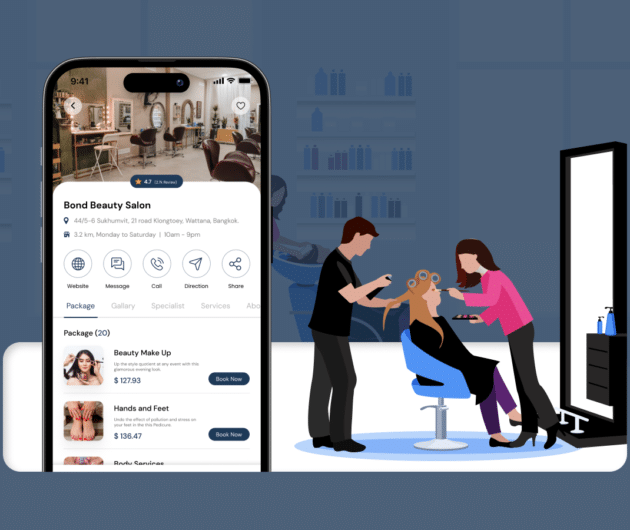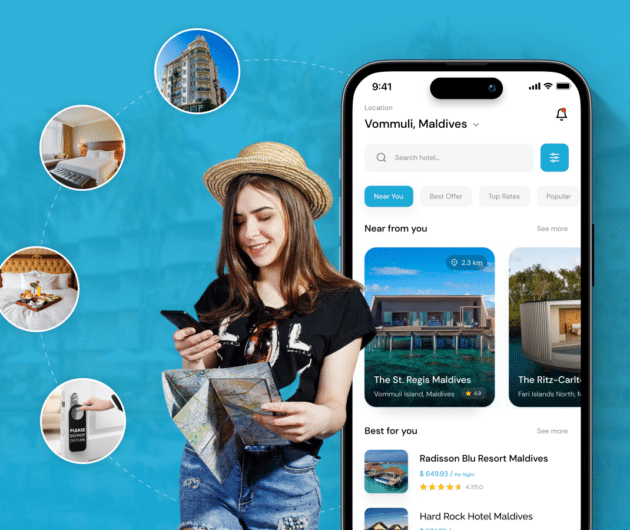Ultimate Guide to Developing a Smart Home Automation App
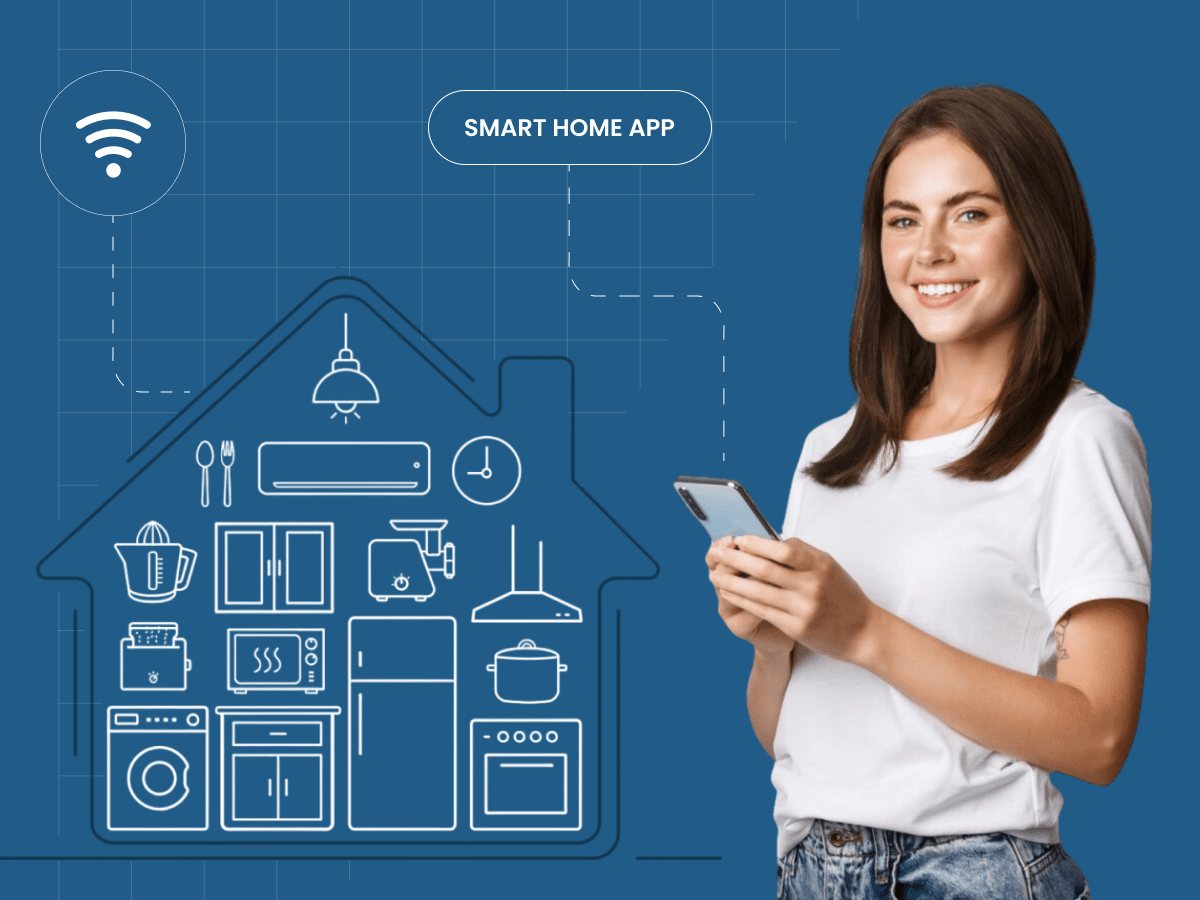
-
Jignesh Nakrani
- July 31, 2023
- 6 min read
This constantly evolving digital era is witnessing remarkable transformations since our parents first purchased our house. Each passing moment has been filled with joy and excitement as we welcomed new appliances into our home, be it a cutting-edge refrigerator with an external water dispenser, a blue tooth equipped microwave oven, or any other modern marvel.
Today, these moments of delight are taking on a new level with the booming home automation market, which is all about networked devices and services that bring home automation to private users. One of the most remarkable aspects of intelligent home automation is the ability to control and monitor individual devices remotely, and sometimes they can even communicate through the Internet of Things (IoT). This intelligent automation gives daily living the highest level of convenience and comfort like never before.
Smart home automation is the future of home living, as people look for ways to make their lives easier and more efficient. With the help of smart devices and apps, you can control your home’s lights, thermostat, security system, and more with just a few taps on your smartphone.
If you’re interested in developing your own smart home application, this guide is for you.
Global Statistics for Smart Home Automation Market
The global smart home automation market is growing rapidly and is expected to reach a value of over $401.87 billion by 2032. Here are some global statistics for the smart home automation market:
- The revenue in the smart home market is projected to reach $117.60 billion in 2022.
- The smart home market size will grow at 12.47% CAGR (2022-2027) and will hit $222.90 billion by 2027.
- Active households in the smart home market are expected to reach 672.60 million by 2027.
- The Asia-Pacific region is the largest market for smart home automation, followed by North America and Europe.
- The most popular smart home devices include smart thermostats, smart locks, and smart speakers.
Source: Statista
How Does Smart Home Automation Work?
Smart home automation works by connecting devices in your home to a central hub or platform. This hub can be a physical device, such as a smart speaker or a home automation controller, or it can be a cloud-based service. Once the devices are connected, you can control them using a smartphone, tablet, or voice assistant.
There are three main components to a smart home automation system:
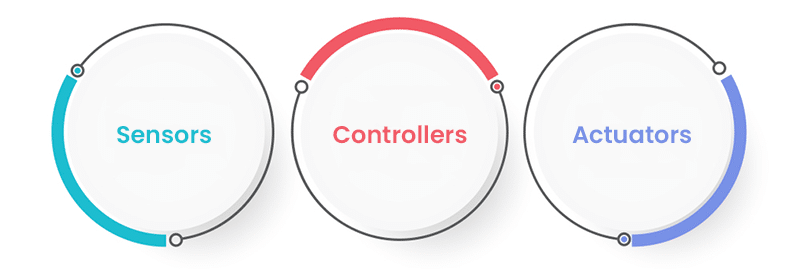
1. Sensors
Sensors detect changes in the environment, such as motion, temperature, or light. They send this information to the hub or platform, which then triggers the appropriate action.
2. Controllers
Controllers are devices that control the operation of other devices in the home. They can be smart plugs, smart thermostats, or even smart light bulbs.
3. Actuators
Actuators are devices that physically control something in the home, such as a light bulb, a door lock, or a thermostat.
Benefits of Building a Smart Home App for Businesses
There are many benefits to building a smart home automation app for businesses. Here are a few of the most important:
• Seamless Integration with Smart Devices
From smart thermostats and lighting systems to security cameras and voice-activated assistants, the app can serve as a central hub, allowing users to control and monitor their smart devices from one user-friendly interface. This integration will enable businesses to collaborate with various smart device manufacturers, expanding their market reach and creating a comprehensive ecosystem for customers.
• Personalized User Experience
A smart home automation app offers users a highly personalized user experience. The app can learn user preferences and behavior patterns by leveraging data analytics and machine learning algorithms, tailoring automation routines to suit individual needs. This personalization enhances user satisfaction and opens avenues for targeted marketing and product recommendations, increasing customer loyalty and engagement.
• Integration with Smart Grids and Demand Response
By allowing users to participate in demand response initiatives, businesses can help them take advantage of utility incentives and rebates. Additionally, such integration facilitates load balancing and grid stability, benefiting utility companies and contributing to a more reliable and efficient energy infrastructure.
• Energy Efficiency and Cost Savings
One of the key advantages of a smart home app development is its potential to promote energy efficiency and cost savings. By empowering users to monitor and control their energy consumption, the app can help them make informed decisions to reduce utility bills and minimize their environmental impact. This aspect can be highlighted as a key selling point, attracting environmentally-conscious customers and positioning the app as a sustainable solution.
Also check: Cost to Develop a Smart Home App Like Vivint
Must-Have Features of a Smart Home Automation App
IoT-based smart home automation applications offer a diverse set of capabilities, empowering users to control and manage various aspects of their homes remotely. Below are key features commonly found in smart home apps:
| Feature | Description |
|---|---|
| Device Control | Remotely controls smart devices such as lights, thermostats, door locks, cameras, and smart plugs. |
| Automation | Create personalized automation routines and schedules for smart devices based on time, conditions, or events. |
| Security and Monitoring | Receive real-time security alerts and monitor connected devices like cameras, motion sensors, and door locks. |
| Energy Management | Monitor and optimize the energy consumption of smart devices to save energy and reduce utility bills. |
| Voice Control | Integrate with popular voice assistants for hands-free device control through voice commands. |
| Scenes and Presets | Create predefined scenes or presets that trigger multiple actions across devices with a single command. |
| User Management | Support multiple user accounts with different permissions and personalized settings. |
| Remote Access | Enable secure remote access to control smart devices from anywhere using smartphones or web interfaces. |
| Integration with IoT Devices | Supports several IoT devices and protocols to ensure compatibility with various innovative home ecosystems. |
| Home Dashboard | Provide an intuitive and user-friendly dashboard to overview all connected devices and their status. |
| Smart Notifications | Deliver intelligent notifications for important events, device malfunctions, low battery levels, etc. |
| Geofencing | Trigger actions based on the user’s location, such as turning off lights when leaving or adjusting a thermostat. |
| Weather Integration | Utilize weather data to automate smart home adjustments based on external temperatures and conditions. |
| Firmware and App Updates | Enable automated updates for the app and connected devices to improve functionality and security. |
Steps to Build a IoT-based Smart Home App
Developing an IoT home automation app requires a systematic approach to ensure its effectiveness and usability. Below is a step-by-step guide to the development process:
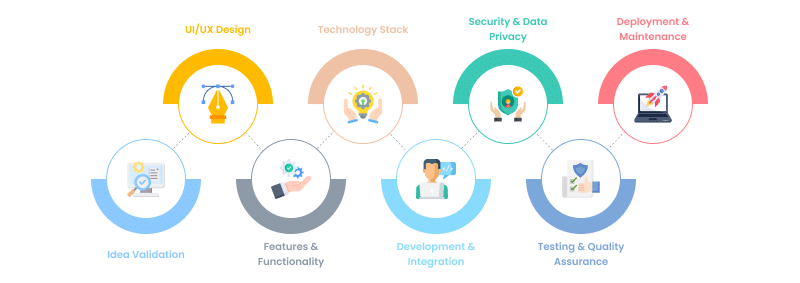
Step 1: Idea Validation and Market Research
Understand the target audience, analyze competitors’ offerings, and validate the app idea to identify unique selling points.
Step 2: UI/UX Design
Create an intuitive and visually appealing user interface (UI) and user experience (UX) design to enhance user engagement and satisfaction.
Step 3: Defining Features and Functionality
List the app’s essential features and functionalities, such as device control, automation scenarios, energy monitoring, and user authentication.
Step 4: Technology Stack Selection
Choose the appropriate technology stack, including IoT technology, cloud platforms, and mobile app development tools.
Step 5: Development and Integration
Develop the app, ensuring smooth integration with various IoT devices and protocols for seamless communication.
Step 6: Security and Data Privacy
Implement robust security measures to safeguard user data and secure communication with connected devices.
Step 7: Testing and QA
Conduct rigorous testing to identify and resolve bugs or issues, ensuring a stable and reliable app performance.
Step 8: Deployment and Maintenance
Launch the app on relevant app stores and provide continuous maintenance and updates to improve functionality and security.

Cost to Build a Smart Home Automation App
The smart home automation app development cost varies due to several factors, including the complexity of features, the number of supported devices, platform compatibility (iOS, Android, or both), and the development team’s hourly rates.
| Factors | Estimated Cost Range |
|---|---|
| Complexity of Features | $15,000 – $40,000 |
| Number of Supported Devices | $5,000 – $15,000 per device |
| Platform Compatibility (iOS, Android, both) | $10,000 – $25,000 per platform |
| Company Hourly Rates | $20 – $80 per hour |
Remember, the actual costs will depend on your app’s specific requirements, features, and scope. It’s crucial to have detailed discussions with a reputable IoT app development company to get precise cost estimates tailored to your project.
Challenges Faced by Businesses in IoT Home Automation App Development
- Interoperability and Compatibility: Smart home devices come from various manufacturers with different communication protocols and standards. Ensuring seamless integration and compatibility between the app and a wide range of smart devices can be complex and challenging. Businesses must invest in extensive testing and development efforts to provide a robust and inclusive user experience.
- Data Security and Privacy Concerns: With the proliferation of IoT devices, data security and privacy become significant concerns. Businesses must implement strong encryption, authentication mechanisms, and data protection measures to safeguard user information from potential cyber threats and unauthorized access. Any data breaches can severely damage a company’s reputation and customer trust.
- User Education and Adoption: While IoT mobile app development is becoming more popular, there is still a need to educate users about the benefits and usage of smart home automation apps. Some users may hesitate to adopt these technologies due to perceived complexities or concerns about data privacy. Businesses must invest in user-friendly interfaces and comprehensive support to encourage widespread adoption.
- Reliability and Performance: Smart home automation apps must be highly reliable and perform consistently to meet user expectations. Downtime, glitches, or delays in controlling smart devices can frustrate users and lead to negative reviews. Maintaining a stable and responsive app requires continuous monitoring and prompt bug fixes.
Final Words
The smart home automation market presents exciting opportunities for entrepreneurs and businesses. With the growing demand for innovative home solutions driven by IoT technology, building a user-friendly and secure smart home automation app can lead to success. While challenges exist, a well-thought-out development process and investment in quality mobile app development services can pave the way for a highly efficient and sought-after intelligent home app. As technology continues to shape our lives, embracing the potential of smart home automation can unlock unprecedented levels of comfort, convenience, and efficiency for homeowners worldwide.
You may also like

How to Choose the Right Mobile App Development Company
-
Ankit Patel
Imagine this: you’ve got a brilliant app idea that could revolutionize your business, take it to new heights, and transform your entire customer experience. But without the right team to… Read More

How Much Does it Cost to Build a Salon Booking App like Fresha?
-
Ankit Patel
We all have witnessed the buzz in the world of beauty & wellness, and it’s booming every day thanks to the fast-paced and stressful lifestyle. In an era where time… Read More

A Complete Guide to Hotel Booking App Development With Cost
-
Ankit Patel
Whether it’s a corporate business trip or a relaxing vacation with friends, finding the right hotel at the right time and a seamless hotel booking experience is not a luxury… Read More


